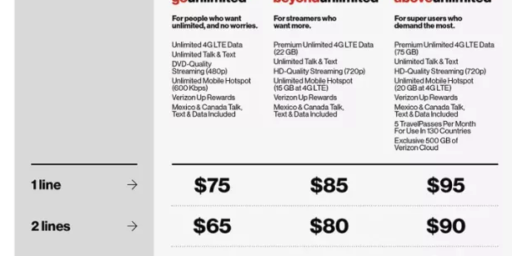Washington Post To Establish Paywall
Following many other newspapers, The Washington Post is about to go behind a paywall:
This summer, The Washington Post will start charging frequent users of its Web site, asking those who look at more than 20 articles or multimedia features a month to pay a fee, although the company has not yet decided how much it will charge.
The paper said, however, that it would exempt large parts of its audience from having to pay the fees. Its home-delivery subscribers will continue to have free access to all of The Post’s digital products. And students, teachers, school administrators, government employees and military personnel will have unlimited access to The Post while in their schools and workplaces.
Access to The Post’s home page, section front pages and classified ads will not be limited.
The step, while modest compared with some other publications, still marks a major change for The Post, which has long shied away from what is known in the business as a paywall for fear of driving away readers and online advertisers. It now joins a long list of other daily publications that charge for content, including the Wall Street Journal, Financial Times, Boston Globe and the New York Times.
“News consumers are savvy; they understand the high cost of a top quality news gathering operation and the importance of maintaining the kind of in-depth reporting for which The Post is known,” Katharine Weymouth, publisher of The Post, said in a statement. “Our digital package is a valuable one, and we are going to ask our readers to pay for it and help support our news gathering as they have done for many years with the print edition.”
People familiar with The Post’s online efforts say the company is planning the release of a new iPad application that it believes will help attract subscribers.
Donald Graham, chairman and chief executive of The Washington Post Co., has been among those most concerned about possible adverse affects of charging for content but has agreed to the model.
“We are obviously looking at paywalls of every type. But the reason we haven’t adopted one yet is that we haven’t found one that actually adds to profits,” Graham said at the UBS Global Media and Communications Conference in December. “But we are going to continue to study every model of paywall and think about that, as well as think about keeping it free.”
Unlike the New York Times or the Wall Street Journal, The Post has traditionally been a local business, pulling in large amounts of local advertising from merchants eager to reach the print audience. By contrast, 90 percent of The Post’s online audience is outside the Washington area.
The fee structure hasn’t been established yet, but I found this interesting:
The Washington Business Journal reported last month that The Post had been surveying users about potential options. It quoted one user as saying that The Post had inquired about seven-day delivery and unlimited Web access for $24.95 a month, unlimited Web access without a print subscription for $14.95 a month, and Sunday delivery and unlimited Web access for $7.95 a month.
Some might consider it non-sensical that the cheapest price would be for Sunday delivery with unlimited web access, but it shows that the Post still plans to rely heavily on ad revenue from its print edition. The Sunday edition is heavily laden with advertising and it is to the Post’s advantage to attempt to increase Sunday subscribers so as to convince advertisers to continue advertising. Will people agree to a seven dollar a month price cut with the understanding that they’ll have to receive the Sunday brick every week? I’m not sure, but I bet many people will find it a tempting offer.
It’s unclear if the Post will follow the example of The New York Times, which allows people to continue to access articles for free if they got it via an RSS feed, Facebook, or TWitter. Quite honestly, that’s how I’ve been accessing the Times for years now. Only occasionally do I click on a link on the home page and thus implicate the paywall. Even with that workaround, though, the Times seems to be fairly pleased with the business success of its paywall. Like the Times, the post is a newspaper of record that’s read throughout the country,so it’s likely they will experience similar success. The newspapers likely to have trouble with paywall’s are smaller market papers that don’t rely upon national audiences.






It must be better than the idiotic Chicago Tribune´s paywall, that bans everyone outside the US from reading most of the paper.
The surprising point, of course, not being the paywall, but that WaPo still is being published.
Speaking of which:
$446. That was WaPo Co.’s share price in Nov. 1997.
$442. That’s WaPo Co.’s current share price.
No splits.
Think about that for a few moments.
I don’t know. I only recently subscribed to the NYT and I read it every day. I can’t remember the last time I read the WaPo.
I subscribe digitally to the NYT and read it everyday. I consider it the best source of news around. In contrast the Post strikes me as so journalistically timid it wouldn’t publish something negative about herpes unless it made it clear they also included the pro-herpes viewpoint.
Good for them. I think all the major, regional, and local newspapers ought to go behind meters, and not be so quick to cannibalize their print editions. At the very least, that might slow their revenue decline down to a more gradual rate, and allow them to face the future with a decent stable of reporters to maintain brand quality.
Local newspapers especially should do this. Their print subscription list is valuable precisely because advertisers can be reasonably certain that they’ll be hitting customers living in a particular area. Not that many people outside of Salt Lake City and Utah, for example, read the Salt Lake Tribune.
The paper here used to do that, too. They’d sign you up just for the Sunday Edition, and throw the rest of the week in for either free or very cheap.
I use the “delete cookies” trick.
There is too much available for free to pay anybody. So easy to get the wire articles, etc. on Yahoo, and given the time I spend on OTB I hardly need more opinions 🙂
As bad as parts of the WaPo can be, I would miss both The Plum Line and Wonkblog.
They should pay US to read Jennifer Rubin.
No matter how much cash was offered, that would still be a human rights violation…
For me the main effect of a WP paywall will be that I stop reading or citing the Washington Post. How that helps the paper is unclear to me.